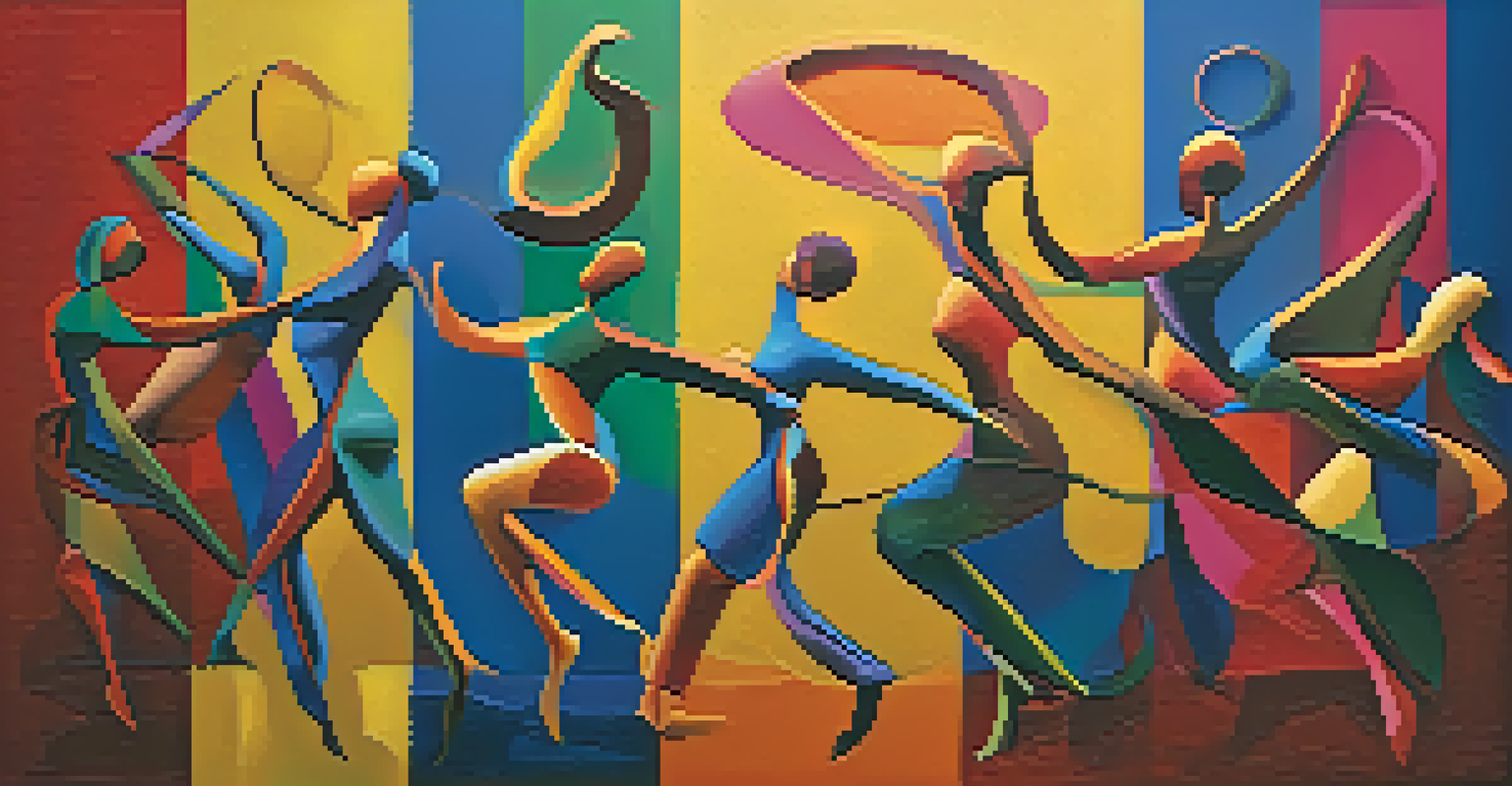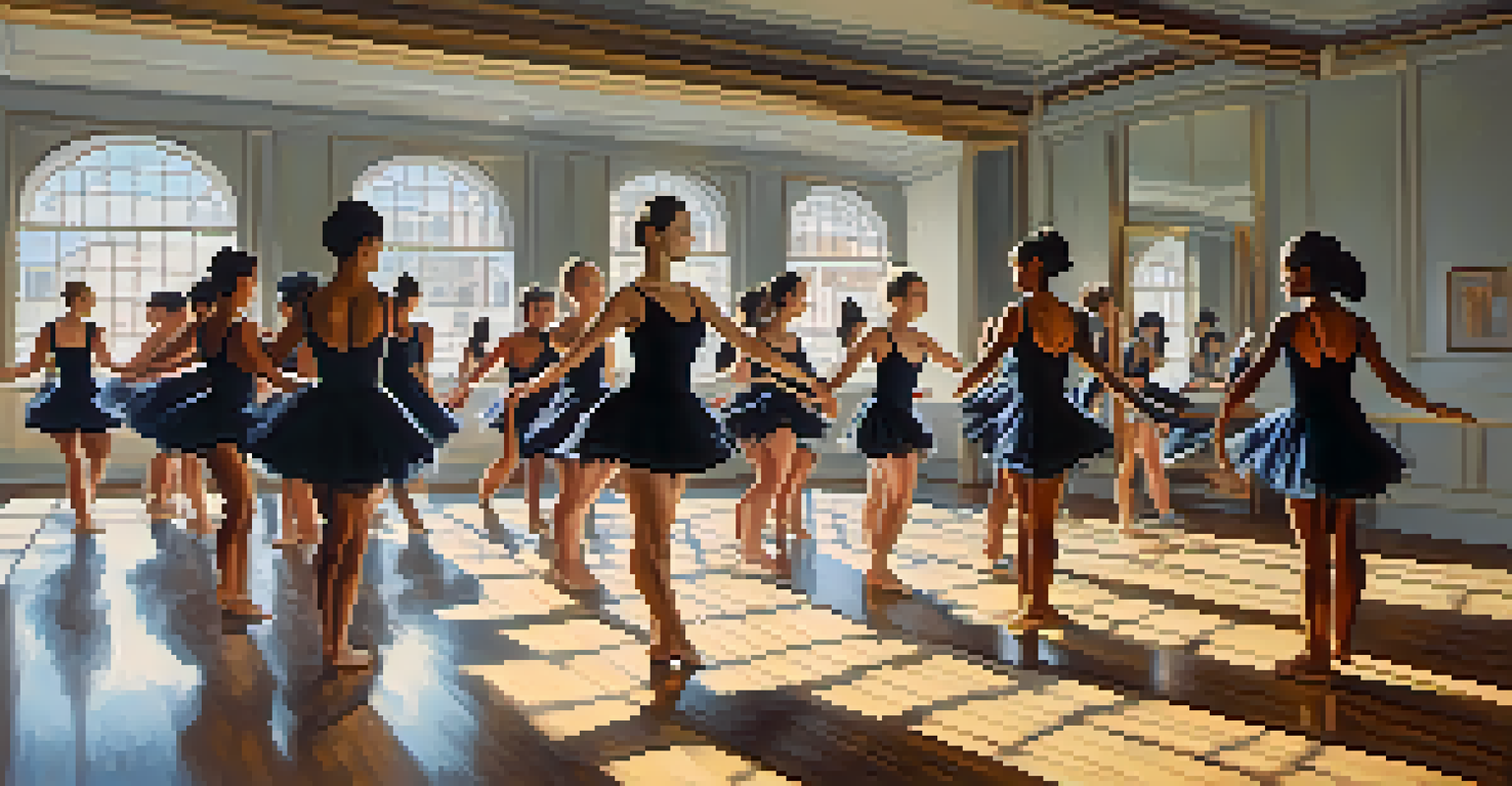Understanding Dance Notation Systems: An Overview of Methods

What is Dance Notation and Its Importance?
Dance notation is a method of visually representing dance movements through symbols and signs. Similar to how sheet music conveys musical notes, dance notation allows choreographers to document their work and share it with others. This becomes particularly vital in preserving the intricacies of a dance piece beyond verbal instruction.
Dance is the hidden language of the soul.
The importance of dance notation cannot be overstated; it acts as a bridge between different generations of dancers and choreographers. By recording movements, styles, and techniques, notation helps to maintain the integrity of a dance form. It also enables dancers to learn and perform pieces accurately, ensuring that the original intent of the choreography is preserved.
Moreover, in an era where dance is increasingly globalized, notation systems serve as a universal language. They provide a way for dancers from diverse backgrounds to collaborate and understand each other’s work, fostering creativity and innovation. Thus, dance notation not only documents but also cultivates a rich, interconnected dance community.
Historical Context of Dance Notation Systems
The roots of dance notation can be traced back to ancient civilizations, where early forms were developed to record ritual dances. For instance, the Greeks had their own systems, while the Chinese developed notational practices that are still studied today. However, the more formalized systems we recognize today began to emerge in the 19th century, alongside the rise of ballet.

One of the earliest and most influential systems was developed by Rudolf Laban, who created Labanotation in the 1920s. This system uses a unique set of symbols to represent movement direction, dynamics, and timing. Labanotation laid the groundwork for other notation systems and is still widely used in dance education and choreography.
Dance Notation Preserves Art Forms
Dance notation serves as a crucial tool for documenting choreography, ensuring the integrity of dance styles is maintained across generations.
As dance evolved, so did the need for more comprehensive notation systems. Different styles of dance, from contemporary to folk, prompted the development of various methods tailored to specific movements and contexts. This evolution reflects the dynamic nature of dance itself, illustrating how notation systems adapt to the changing landscape of artistic expression.
Labanotation: The Pioneer of Dance Notation
Labanotation stands out as one of the most recognized dance notation systems in the world. It employs a series of symbols that represent body movements, spatial orientation, and time, providing a detailed account of choreography. Dancers and choreographers often use this system for its precision and clarity, making it an essential tool in dance education.
The dance is a poem of which each movement is a word.
The symbols in Labanotation can seem complex at first glance, but they offer a comprehensive way to capture intricate movements. For example, a circle might represent a full turn, while lines indicate the path of movement. By translating physical actions into symbols, Labanotation allows for a deeper understanding of how dance is structured.
Additionally, Labanotation is not just limited to ballet or contemporary dance; it can be adapted to various dance forms, enhancing its versatility. This adaptability makes it invaluable in documenting diverse dance styles, ensuring that the richness of global dance heritage is preserved for future generations.
Benesh Movement Notation: A Visual Approach
Benesh Movement Notation offers a more visual representation of dance movements, contrasting with Labanotation's abstract symbols. Developed by the Benesh family in the mid-20th century, this system uses a staff-like format, with movements notated in relation to the body’s position. This makes it particularly appealing to those who are visually oriented and prefer a more intuitive approach to dance notation.
One of the significant advantages of Benesh notation is its accessibility; dancers can easily interpret and execute the movements marked on the staff. This system is especially popular in ballet, as it captures the elegance and fluidity of the form beautifully. By providing a clear visual guide, it helps dancers learn choreography more efficiently.
Labanotation: A Key Notation System
Labanotation stands out for its detailed representation of movements, making it an essential resource for dancers and choreographers.
Furthermore, Benesh Movement Notation is often used in academic settings for dance analysis and research. By documenting performances this way, scholars can study and critique dance works, contributing to a deeper understanding of the art. This combination of practicality and scholarly value makes Benesh notation a vital part of the dance notation landscape.
Other Dance Notation Systems: A Brief Overview
While Labanotation and Benesh Movement Notation are two of the most recognized systems, there are several other dance notation methods worth noting. For instance, the
Graham Technique notation was developed by Martha Graham and focuses on the unique movements of her technique. This system is tailored to capture the essence of her work, highlighting the emotional and physical aspects of the dance.
Another interesting system is the
Synchronous Movement Notation used in African dance, which emphasizes the communal aspect of performance. Each notation system reflects its cultural context and the specific needs of the dance style it represents, showcasing the diversity in the world of dance notation.
The Role of Technology in Dance Notation
In recent years, technology has significantly influenced the field of dance notation. Software applications and digital platforms are now available, making it easier for choreographers to document their work visually and share it with others. These innovations not only streamline the process but also enhance the accessibility of dance notation.
For example, some programs allow users to create digital representations of movements, complete with video integration. This provides a multi-dimensional experience, combining written notation with visual demonstrations. As a result, dancers can grasp the nuances of choreography more effectively.
Technology Enhances Dance Notation
Advancements in technology are revolutionizing dance notation, allowing for more accessible and collaborative documentation of choreography.
Moreover, technology fosters collaboration among dancers and choreographers globally. By utilizing online platforms, artists can share their work, receive feedback, and even collaborate on projects without geographical limitations. This interconnectedness enriches the dance community and promotes a more inclusive approach to choreography.
Conclusion: The Future of Dance Notation Systems
As dance continues to evolve, so too will the systems used to document and interpret it. The future of dance notation systems is likely to be characterized by further integration of technology, enabling even more sophisticated and user-friendly methods. This will ensure that dance remains accessible to a wider audience and continues to inspire new generations of artists.
Moreover, the importance of preserving cultural heritage through notation cannot be underestimated. As various dance forms face the risk of fading away, robust notation systems will play a critical role in safeguarding these art forms for posterity. The documentation of diverse styles will enrich the global dance landscape and foster a greater appreciation for its myriad expressions.

In conclusion, understanding dance notation systems allows us to appreciate the complexity and beauty of choreography. By exploring these methods, we can recognize the significance of documenting dance, not just for current practitioners, but for the future of this vibrant art form.